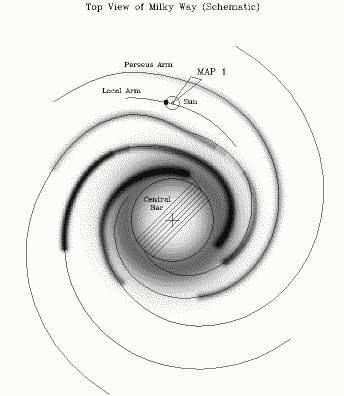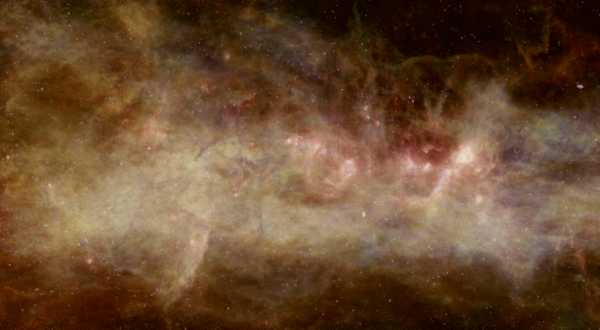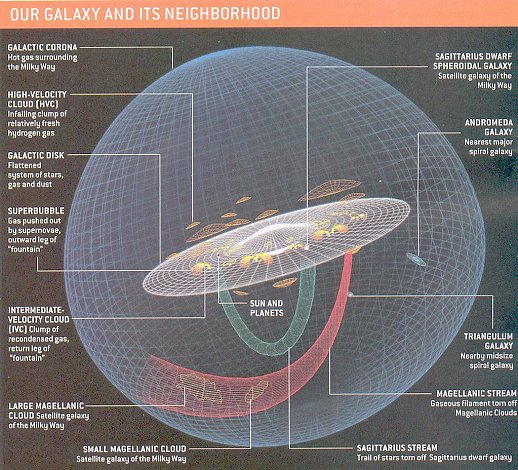The Galaxy
Across the Sea of Stars takes place in our Milky Way galaxy.
We live on a hunk of rock and metal that circles a humdrum star that is one of 400 billion other stars that make up the Milky Way Galaxy which is one of billions of other galaxies which make up a universe which may be one of a very large number, perhaps an infinite number, of other universes. That is a perspective on human life and our culture that is well worth pondering.
Carl Sagan
One light year is approximately 5,878,499,810,000 miles or 9,460,528,400,000 kilometers. Our galaxy is estimated to be 100,000 light years across. Looking down on the Milky Way Galaxy, the structure is approximately:

(Image produced by NASA Astrophysics Data Facility)
The fastest Coterie ships can sustain hyperspatial travel of around 10 light yearcycles per daycycle. Even at these velocities, in excess of 3,600 times the speed of light, the Galaxy is still a vast place. The reality is that these velocities are only attainable under the best situations, in the emptier regions of the Galaxy, where gravitational fields and hyperspatial distortions are minimized.

(Image taken from Canadian Galactic Plane Survey)
Travel through the denser regions of the galactic arms can be significantly slower than 3,000 times the speed of light. The image above, which shows the midplane of the Galaxy looking towards Perseus (Map 1 on the schematic of the Milky Way) should give some idea of the density of stars and systems along a galactic arm. The hyperspatial map, which shifts with time, is considerably more complex.
Are we there yet?
Nearly every space traveller
Most practical long-distance hyperspatial velocities are impossible in the inner region of the Galaxy, the home of the Core Worlds. In the Core, stars are close to each other, frequently less than a light yearcycle apart. Shifting gravitational fields, along with intense magnetic and radiation gradients create hazardous navigational challenges for even the most experienced pilots and navigators.
Looking outward, there is considerable structure even as one heads into the Great Dark:

(Image taken from Scientific American — Our Growing, Breathing Galaxy [link no longer available])
There are uncountable galaxies beyond our own. Probabilities suggest that each galaxy is swarming with intelligent life, though the Coterie has only contacted beings in a few of the nearest neighbors. There is even some commerce through the Great Dark, though it is slow — only for knowledge and the highest value curiousities.
The intergalactic voids are generally empty enough that maximum velocities can be attained. Long cruises at ten light yearcycles a daycycle are frequent on ships that keep the strictest maintenance regimens. Ships must be self-sufficient and self-sustaining for these long journeys, for there are no places to stop along the way.
| Rank | Galaxy | Distance from Earth (in light yearcycles) | Travel Time (yearcycles) at 10 LY/day | Notes |
| 1 | Milky Way Galaxy | 0 | N/A | Home galaxy of Coterie |
| 2 | Canis Major Dwarf Galaxy | 25,000 | 6.9 | Satellite of Milky Way. |
| 3 | Sagittarius Dwarf Elliptical Galaxy | 81,000 | 22.2 | Satellite of Milky Way. |
| 4 | Large Magellanic Cloud | 160,000 | 43.8 | Satellite of Milky Way. |
| 5 | Small Magellanic Cloud | 190,000 | 52.1 | Satellite of Milky Way. |
| 6 | Ursa Minor Dwarf Galaxy | 205,500 | 56.3 | Satellite of Milky Way |
| 7 | Draco Dwarf Galaxy | 248,000 | 67.9 | Satellite of Milky Way |
| 8 | Sculptor Dwarf Galaxy | 254,000 | 69.6 | Satellite of Milky Way |
| 9 | Sextans Dwarf Galaxy | 257,500 | 70.6 | Satellite of Milky Way |
| 10 | Carina Dwarf Galaxy | 283,500 | 77.7 | Satellite of Milky Way |
| 11 | Fornax Dwarf Galaxy | 427,000 | 117 | Satellite of Milky Way |
| 12 | Leo II Dwarf Galaxy | 701,000 | 192 | |
| 13 | Leo I Dwarf Galaxy | 890,000 | 243.8 | |
| 14 | Phoenix Dwarf Galaxy | 1,271,000 | 348 | |
| 15 | Barnards Galaxy (NGC 6822) | 1,760,000 | 482 | |
| 16 | NGC 185 | 2,021,000 | 553.7 | Satellite of Andromeda |
| 17 | NGC 147 | 2,152,000 | 589.6 | Satellite of Andromeda |
| 18 | Andromeda Galaxy (M31) | 2,363,000 | 647.4 | |
| 19 | M32 (NGC 221) | 2,363,500 | 647.5 | Satellite of Andromeda |
| 20 | M110 (NGC 205) | 2,363,500 | 647.5 | Satellite of Andromeda |
| 21 | Andromeda I | 2,363,500 | 647.5 | Satellite of Andromeda |
| 22 | Andromeda II | 2,363,500 | 647.5 | Satellite of Andromeda |
| 23 | Andromeda III | 2,363,500 | 647.5 | Satellite of Andromeda |
| 24 | LGS 3 | 2,477,500 | 678.8 | Satellite of Triangulum |
| 25 | IC 1613 | 2,494,000 | 683.3 | |
| 26 | Triangulum Galaxy (M33) | 2,592,000 | 710.1 | |
| 27 | Aquarius Dwarf Galaxy | 2,608,000 | 714.5 | |
| 28 | Tucana Dwarf Galaxy | 2,836,000 | 777 | |
| 29 | Wolf Lundmark Melotte Galaxy (WLM) | 3,064,500 | 839.6 |